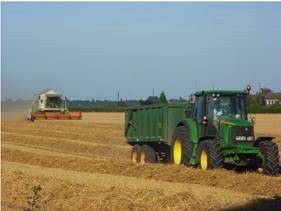Common Agricultural Policy

Common Agricultural Policy (CAP) - subsidies, price floors and buffer stocks
 The Common Agricultural Policy was created by the Treaty of Rome in 1957 and introduced in 1962. It was designed to offer minimum guaranteed prices to European farmers to ensure a consistent and reliable supply of food throughout the European community. The historical context was the 'Cold War' and the Berlin crisis and the desire by European Governments to ensure food supplies were maintained and available in times of war and political crisis. However, as political tensions reduced, the CAP essentially became a mechanism to control the production and price of food within the EU, using subsidies as its main policy instrument.
The Common Agricultural Policy was created by the Treaty of Rome in 1957 and introduced in 1962. It was designed to offer minimum guaranteed prices to European farmers to ensure a consistent and reliable supply of food throughout the European community. The historical context was the 'Cold War' and the Berlin crisis and the desire by European Governments to ensure food supplies were maintained and available in times of war and political crisis. However, as political tensions reduced, the CAP essentially became a mechanism to control the production and price of food within the EU, using subsidies as its main policy instrument.
The CAP was based on the economic principle of a 'price floor'. Farmers were guaranteed a price for each unit of output regardless of amount produced; if farmers could double or treble output, they could double or treble their income. When market prices fell below an agreed level, the community intervened to buy surplus farm output. These buffer stocks were supposed to be used in time of food shortages. The CAP certainly helped reduce Europe's reliance on imported food, but in practice, technological advances soon led to massive over-production and the creation of the now legendary 'mountains' and 'lakes' of surplus food and drink. These became so substantial and politically sensitive, that the EU was forced to introduce the concept of 'set-aside' to reduce these large and costly surpluses by paying farmers not to grow certain crops.
Although the concept of the CAP is simple, its operation is not. The CAP has become one of the most controversial European Union policies. Almost 90% of the European Union (EU) land area is considered to be rural in nature, with 26% of the population living there. At one stage nearly three quarters of the entire EU budget was spent on farming. After several reforms this figure has been cut to approximately one third of the budget, but there is still pressure to lower this further as farming only employs 5% of the EU workforce and contributes less than 3% of the total EU Gross Domestic Product.
Supporters of the CAP argue that it helps to ensure affordable food with the average EU household presently devoting 15% of its expenditure to food compared to 30% in 1960. They also maintain that the policy is crucial to sustaining rural communities claiming many farmers would have gone out of business if it were not for EU support.
CAP generates much hostility across Europe. There are many organisations and individuals that oppose the Common Agricultural Policy both in its operation and in principle.
Critics of the CAP identify significant problems, arguing that:
- surpluses are a waste of scarce resources
- high prices prevent fair trade and make it difficult for farmers in the developing world to compete in EU agricultural markets
- inequalities in agriculture are increased
- high food prices penalise the poorer members of society
- the policy has had damaging effects on the environment as it encourages over-production at the guaranteed price regardless of environmental impacts
- many of the surpluses generated are 'dumped' on world markets, distorting those markets and increasing the divide between rich and poor nations further
How EU farm policy hurts poor countries: Daniel Hannan, MEP
Since 2005, farmers are no longer subsidised to maintain production, but instead receive a lump-sum called the Single Farm Payment (SFP) designed to match supply to consumer demand, with farmers now paid for their role as guardians of the countryside.
In May 2008, following a major review by the European Commission, set-aside was abolished with farmers now subsidised to grow crops for biofuels, which are considered more environmentally friendly than fossil fuels. The CAP is due to be reviewed again in 2013 and there is speculation that reforms could shift spending from the CAP towards innovation, climate and energy.

You may also like to read the following articles:
